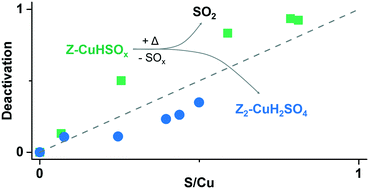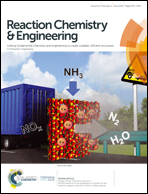Site selective adsorption and relocation of SOx in deactivation of Cu–CHA catalysts for NH3-SCR
Abstract
The presence of SO2 in diesel exhaust gases causes severe deactivation of the Cu–CHA catalysts for the reduction of NOx by selective catalytic reduction with ammonia (NH3-SCR). The deactivation of Cu–CHA catalysts after exposure to SO2 at 550 °C for 0.5, 4, 8, 16 and 32 h, and subsequent regeneration in SO2-free gas at 550 °C was related to the site-dependent interactions of SO2 with Cu ions associated with one or two framework Al centers (Z-CuOH or Z2-Cu), as determined by electron paramagnetic resonance (EPR). SO2 primarily interacts with the EPR-silent Z-CuOH sites, but a new, EPR-active Z2-Cu phase develops with SO2 exposure time as well. A part of the original Z2-Cu species remain unaffected by SO2, which is associated with a maximum deactivation level of about 90%. Regeneration at 550 °C leads to the release of most of the SO2 from the Z-CuOH sites and some relocation of sulfur to Z2-Cu sites occurs. The activation energy for NH3-SCR on the SO2 exposed catalysts decreases with S content from about 65 kJ mol−1 to 30 kJ mol−1. For the regenerated catalysts, the activation energy is restored to about 65 kJ mol−1, showing the importance of the Z-CuOH sites for the NH3-SCR reaction.

- This article is part of the themed collection: Selective catalytic reduction of NOx


 Please wait while we load your content...
Please wait while we load your content...